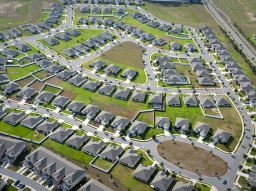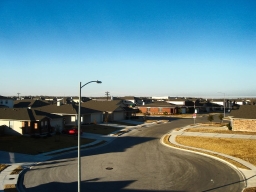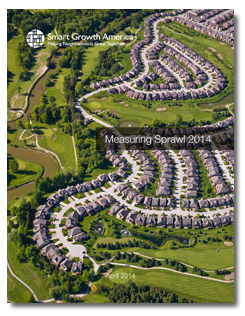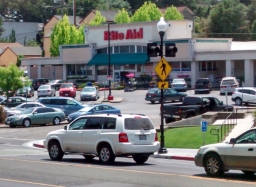 'American governments continue to be obsessed with maximizing people’s capacity to travel, even as they ignore minimizing the amount people have to travel. Not only must American families pay the taxes to support this continually-expanding system, but to live in it they are required to purchase, maintain, and store a fleet of vehicles even as they endure heightened sensitivity to oil price fluctuations (and support the military adventures that result).
'American governments continue to be obsessed with maximizing people’s capacity to travel, even as they ignore minimizing the amount people have to travel. Not only must American families pay the taxes to support this continually-expanding system, but to live in it they are required to purchase, maintain, and store a fleet of vehicles even as they endure heightened sensitivity to oil price fluctuations (and support the military adventures that result).
Like Medicare, Social Security, and a myriad of other federal initiatives, housing and transportation subsidy programs are as popular today as they are financially insolvent. In an effort to prop up our suburban experiment, we now have the Federal Reserve owning the mortgage-backed securities market while Republicans in Congress champion “pension smoothing” as a way to pretend an insolvent federal highway trust fund can continue to build more roads. As with any over-centralized effort, a lack of appropriate feedback mechanisms allows the system to continue barreling down its present course–until it buckles under its own insolvency. Our suburban experiment has an expiration date.
The sad reality is that, despite the marketing, the suburbs were never about creating household wealth; they were about creating growth on the cheap. They were born under a Keynesian regime that counted growth from government spending as equivalent to that coming from private investment. Aggressive horizontal expansion of our cities allowed us to consistently hit federal GDP and unemployment targets with little sophistication and few difficult choices.
That we were pawning off the enormous long-term liabilities for serving and maintaining all of these widely dispersed systems onto local taxpayers–after plying municipalities with all the subsidies, pork spending, and ribbon cuttings needed to make it happen–didn’t seem to enter our collective consciousness. When all those miles of frontage roads, sewer and water pipes, and sidewalks fall into disrepair–as they inevitably will in every suburb–very little of it will be fixed. The wealth necessary to do so just isn’t there.
To quote the late columnist Earl Wilson, “Modern man drives a mortgaged car over a bond-financed highway on credit card gas.” Debt-to-income and debt-to-assets ratios for U.S. households have grown steadily during suburban expansion.'
- Charles Marohn, The Conservative Case Against the Suburbs
 'Our responses to distance are quite predictable. Most of us will walk to a corner store rather than climb in and out of the car if it’s less than a five-minute walk—about a quarter mile—away. Kids move by a similar calculus. Frank found that if there is a park or some kind of store within a half mile of their home, school-age youth are more than twice as likely to walk. If destinations are farther, they wait for a parental chauffeur.
'Our responses to distance are quite predictable. Most of us will walk to a corner store rather than climb in and out of the car if it’s less than a five-minute walk—about a quarter mile—away. Kids move by a similar calculus. Frank found that if there is a park or some kind of store within a half mile of their home, school-age youth are more than twice as likely to walk. If destinations are farther, they wait for a parental chauffeur.
Having a finely grained street grid is incredibly important to walkable communities. Side-by-side maps show how windy, disconnected, suburban streets make it difficult-to-impossible to get around on foot. Read More and peruse the Maps at usa.streetsblog.org.
 "This year, Smart Growth America updated Measuring Sprawl and Its Impact, a 2002 study that has been widely used by researchers to examine the costs and benefits of sprawling development. In peer-reviewed research, sprawl has been linked to physical inactivity, obesity, traffic fatalities, poor air quality, residential energy use, emergency response times, teenage driving, lack of social capital and private-vehicle commute distances and times.
"This year, Smart Growth America updated Measuring Sprawl and Its Impact, a 2002 study that has been widely used by researchers to examine the costs and benefits of sprawling development. In peer-reviewed research, sprawl has been linked to physical inactivity, obesity, traffic fatalities, poor air quality, residential energy use, emergency response times, teenage driving, lack of social capital and private-vehicle commute distances and times.
 "There is a growing body of evidence that shows how sprawl is bankrupting communities that cannot keep up with the maintenance of all the infrastructure required to serve the sprawl. New infrastructure (streets, water, sewer, electric, gas) is often conditioned on the developer to install, but they have no obligation to maintain it. That responsibility falls on the local jurisdiction. However, the taxes generated by sprawling developments come nowhere close to being able to pay for the maintenance on the infrastructure. - Paul Fritz Read More
"There is a growing body of evidence that shows how sprawl is bankrupting communities that cannot keep up with the maintenance of all the infrastructure required to serve the sprawl. New infrastructure (streets, water, sewer, electric, gas) is often conditioned on the developer to install, but they have no obligation to maintain it. That responsibility falls on the local jurisdiction. However, the taxes generated by sprawling developments come nowhere close to being able to pay for the maintenance on the infrastructure. - Paul Fritz Read More
"The term "urban sprawl" has a bad ring to it. My study of metropolitan growth indicates that three kinds of development are typical of what we call urban sprawl. They include: leapfrog development, strip or ribbon development, and low-density, single dimension development. Let's look at each type in turn." - Randall G. Holcombe. Read more...
-
Urban Sprawl: Pro and Con
In Defense of Urban Sprawl
- See more at: http://perc.org/articles/urban-sprawl-pro-and-con#sthash.nkUwMdjo.dpuf
-
Urban Sprawl: Pro and Con
In Defense of Urban Sprawl
- See more at: http://perc.org/articles/urban-sprawl-pro-and-con#sthash.nkUwMdjo.dpuf"At the sprawling edge of the city, and further in if the sprawl tendency has been ongoing for the last 50 or 60 years, traffic seems to become ever more severe. So one of the effects of urban sprawl is that the road transportation system has to be lengthy, miles driven and traffic congestion are high, transit becomes cost-ineffective because overall density is low, and walking is nearly impossible in some suburban locations.
Read more: The High Costs of Automobile-Dependent Transportation
"Runaway growth is not inevitable. Hundreds of urban, suburban and rural neighborhoods are choosing to manage sprawl with smart growth solutions. These solutions, including establishing urban growth boundaries, preserving farmland and green space, investing in alternate forms of transportation, and building compact pedestrian-friendly neighborhoods, can help manage growth and control sprawl."
“Well, let me state it unequivocally: I love sprawl. I need it. I promote it. Oakland County can’t get enough of it,”
- L. Brooks Patterson, Oakland County Chief Executive
Planning Resources Online
- Beckett & Raeder (Our Former Planner)
- Carlisle/Wortman Associates (Our Former Planner)
- MapWashtenaw - GIS
- McKenna Associates (Our Current Planner)
- MDEQ - MiWaters - Water Resources Information and Forms
- Michigan Association of Planning
- Michigan Planning Enabling Act of 2008
- MSU Extension's Planning and Land Use Links
- MSU Planning & Zoning Center
- SEMCOG (Southeast Michigan Council of Governments)

